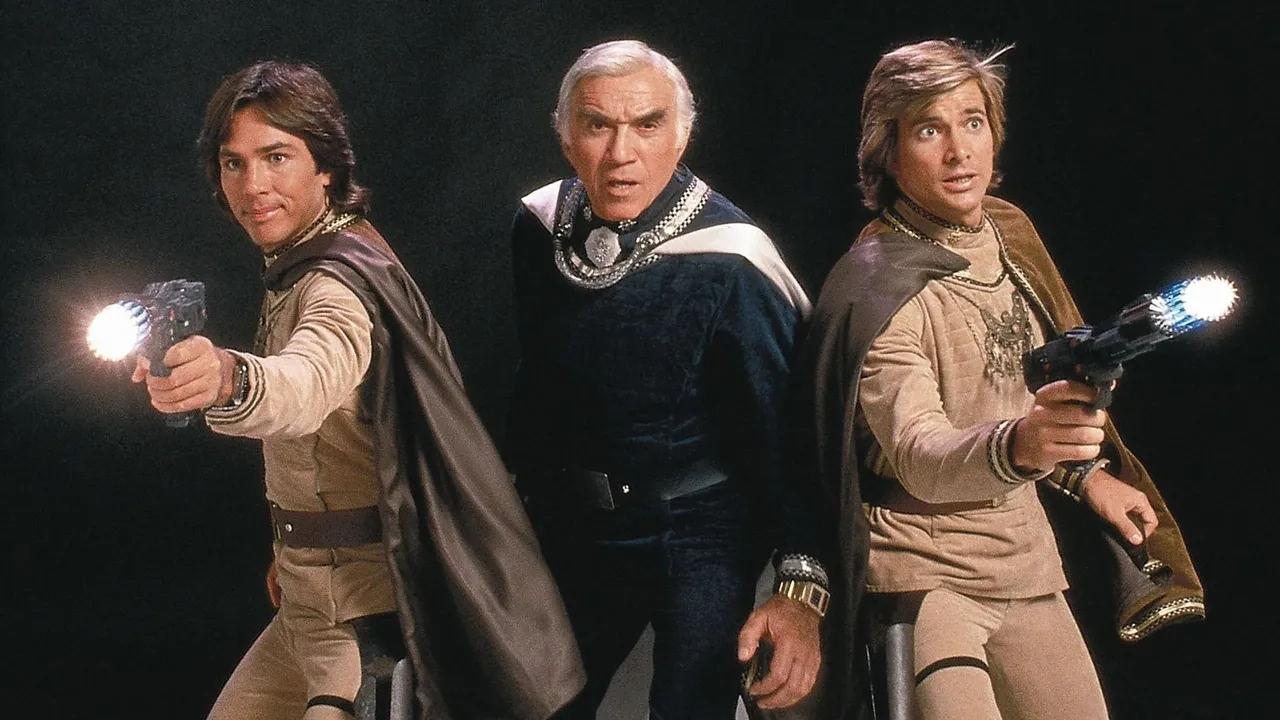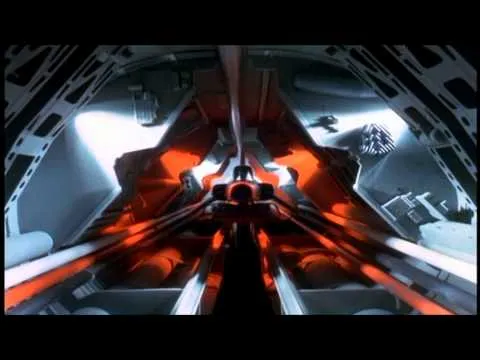
We live in a Golden Age of Television and, consequently, the audience, spoiled by seemingly limitless choices and rising quality, tends to take too many things for granted. How far television has advanced is best seen when popular 21st Century television shows are compared with their counterparts from the past. One such examples could be found in the original version of Battlestar Galactica, arguably the most ambitious project of 1970s American television which made huge impact and created small but extremely loyal fan base, but nevertheless couldn’t overcome technical, financial, cultural and other limitations of its era.
The basic plot is, more or less, the same as in the better known, 2000s “re-imagined” version. Opening narration in each episodes speculates that the Earth’s population might be just one of the branches of humanity scattered throughout the space and that, out there, they might be other human civilisations, perhaps even connected to those from Earth’s ancient past. One such civilisation is represented in Twelve Colonies or, to be more precise, was represented in Twelve Colonies, that were wiped out in a treacherous attack by reptilian-robotic alien race of Cylons in the opening episode. What has left of the humanity has gathered in the fleet of ships led by Battlestar Galactica, the only surviving capital ship of Colonial Fleet, led by Commander Adama (played by Lorne Greene), and begins long and perilous journey to long-lost semi-mythical thirteenth colony known as “Earth”.
When it premiered in Autumn of 1978, Battlestar Galactica has been savaged by critics as “cheap imitation” of Star Wars. Word “cheap” is, however, difficult to associate with the series started by a pilot episode which became the most expensive television film produced by that time, with a budget only slightly smaller than George Lucas’ epic space opera. Large budget is quite obvious due to Richard Dykstra’s special effects that were most advanced at the time and that look impressive even today. Series creator Glen A. Larson has envisioned Battlestar Galactica long before Star Wars, inspired by his own Mormon upbringing as well as Ancient Aliens hypothesis, which was widely popularised by Erich von Däniken in 1970s. Large budgets also allowed for this ideas to be reflected in inventive costumes, props, iconography and creative energy was even invested in the language spoken in series, with certain words (like “yaren” instead of “years”) clearly indicating that the civilisation of Twelve Colonies was similar but very different from our own. Language also allowed producers to cheat strict censorship characteristic for 1970s television, with words like “frack” being liberally used instead of its four-letter equivalents or character of Cassiopeia (played by Laurette Spang) being described as “socialator” instead of member of profession which was not supposed to be shown on family-friendly television shows.
Among creative talents involved in Battlestar Galactica was composer Stu Phillips, whose soundtrack includes powerful opening theme which represents one of the most easily recognisable pieces of film and television music, an achievement producers of 2000s version failed to make. The series also had very good cast, most notably television veteran Lorne Greene, whose excellent voice and charismatic presence gave the show necessary gravitas and helped its plot be taken seriously even in its sillier moments. However, like 2000s version, this was mostly an ensemble show. Richard Hatch as Captain Apollo Adama’s son and heroic leader of fighter pilots, created interested “buddy buddy” dynamic with Dirk Benedict as his good friend, cigar-smoking, hard drinking and adventurous pilot whose womanising antiques often provided light-hearted content in what was actually rather dark story about remains of humanity barely escaping genocide. The rest of the cast was also good, including Anne Lockhart as Lt. Sheba, tough female pilot that easily transcended sexist stereotypes of 1970s television. Even when characters were one-dimensional villains, like Count Baltar who is incredibly simple in comparison with its 2000s equivalent, they were elevated by inspired cast, with John Collicos playing him with gusto, creating quite memorable performance. That can be said even for actors who appear as guests, like Llyod Bridges as Commander Cain in two-part episode Living Legend, Fred Astaire as conman Chameleon in Man With Nine Lives and Patric MacNee as enigmatic Count Iblis in two-part episode War of the Gods. The latter episode is one of the best in the series, mostly because inventive and potentially controversial dabbling into explicitly religious themes.
Battlestar Galactica, however, had its share of flaws. One of the most obvious and annoying was the character of Boxey, six-year old boy (played by Noah Hathaway), who is given a robotic dog named Muffit II (actually played by a chimpanzee in a suit); an attempt to cater to the youngest audience didn’t exactly work, especially in episodes with otherwise serious plots when those two play important roles. But the more important and, in the end fatal, flaw of the series had little to do with its authors. The show was aired on ABC, broadcast television network with leadership unwilling to think outside the box. Glen A. Larson has originally devised Battlestar Galactica as the series of feature-length and high budget television films, very much like the pilot. What this concept could have lead to is best shown in quality two-part episodes like War of the Gods or Gun on Ice Planet Zero, which was inspired by WW2 action classic like The Guns of Navarone and might have inspired George Lucas for The Empire Strikes Back. Unfortunately, ABC leadership stuck to the concept of the regular weekly show which resulted in a limited budgets for each episode. This became apparent with cheap sets, including those previously used from western shows, as well as recycling of space combat scenes, which became more and more annoying as the show went on. All this resulted in many episodes being subpar and laughable, but the cost still remained high and show couldn’t escape cancellation after single season. Next year, an attempt was made to cash in show popularity with “clever” idea of a cheap sequel being set on present-day Earth in Galactica 1980, a show so disastrous that most fans of original Galactica like to pretend that it never existed. Among them was Richard Hatch, who would spend decades trying to start the sequel only to reluctantly appear in reimagined version. There are still rumours about third incarnation of this show that might be remake or a sequel, in both cases well-deserved.
Starring: Richard Hatch, Dirk Benedict, Lorne Greene, John Colicos, Maren Jensen, Noah Hathaway, Herbert Jefferson Jr., Tony Swartz, Laurette Spang, Terry Carter, Anne Lockhart
Executive producers: Glen A. Larson
Running Time: 24 episodes (21 + 3-part pilot episode, 45 minutes each)
Pro: intriguing idea, very good special effects, creative props and iconography, memorable music, very good cast
Contra: most of episodes being subpar, annoying childish plots, poor budgets, unfinished
.
RATING: 7/10
Blog in Croatian https://draxblog.com
Blog in English https://draxreview.wordpress.com/
Leofinance blog @drax.leo
Cent profile https://beta.cent.co/@drax
Minds profile https://www.minds.com/drax_rp_nc
Uptrennd profile https://www.uptrennd.com/user/MTYzNA
Hiveonboard: https://hiveonboard.com?ref=drax
Rising Star game: https://www.risingstargame.com?referrer=drax
1Inch: https://1inch.exchange/#/r/0x83823d8CCB74F828148258BB4457642124b1328e
BTC donations: 1EWxiMiP6iiG9rger3NuUSd6HByaxQWafG
ETH donations: 0xB305F144323b99e6f8b1d66f5D7DE78B498C32A7

